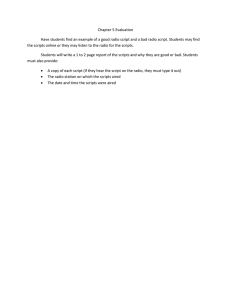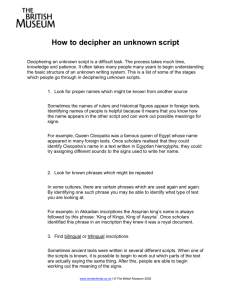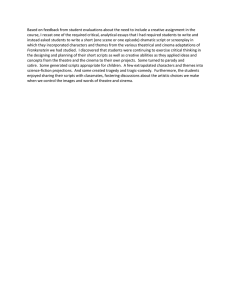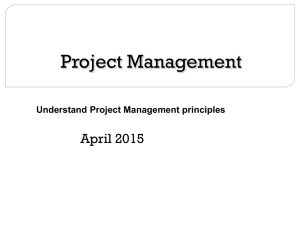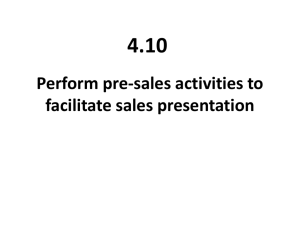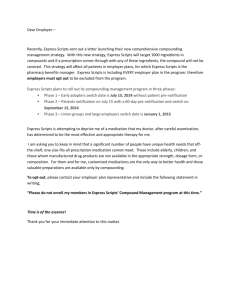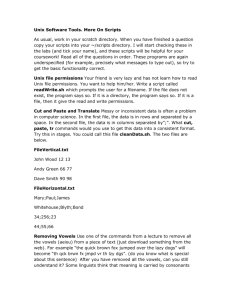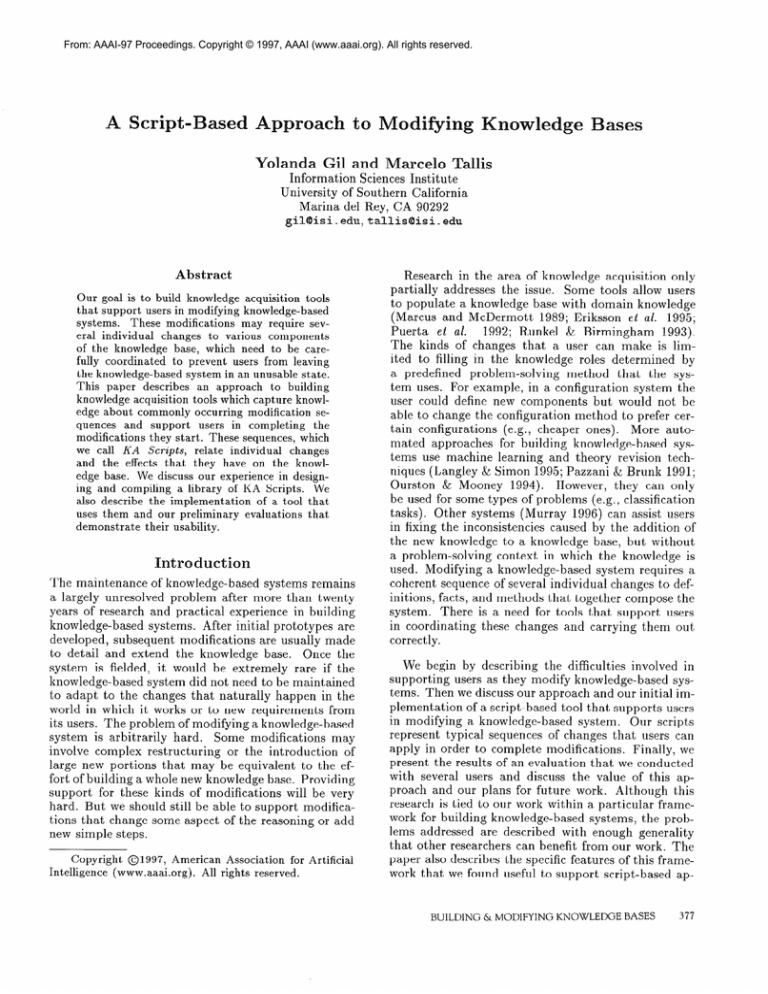
From: AAAI-97 Proceedings. Copyright © 1997, AAAI (www.aaai.org). All rights reserved.
ach
Ydanda
to
MO
Gil and Marcello Tallis
Information
Sciences Institute
University of Southern California
Marina de1 Rey, CA 90292
gil@isi.edu,tallis@isi.edu
Abstract
Our goal is to build knowledge acquisition tools
that support users in modifying knowledge-based
systems.
These modifications
may require several individual
changes to various components
of the knowledge
base, which need to be carefully coordinated
to prevent users from leaving
the knowledge-based
system in an unusable state.
This paper describes
an approach
to building
knowledge acquisition tools which capture knowledge about commonly
occurring modification
sequences
and support
users in completing
the
modifications
they start. These sequences, which
we call ICA Scripts,
relate individual
changes
and the effects that they have on the knowledge base. We discuss our experience in designing and compiling
a library of KA Scripts.
We
also describe the implementation
of a tool that
uses them and our preliminary
evaluations
that
demonstrate
their usability.
Introduction
The maintenance
of knowledge-based
systems remains
a largely unresolved problem after more than twenty
years of research and practical experience in building
knowledge-based
systems. After initial prototypes are
developed, subsequent modifications
are usually made
to detail and extend the knowledge base.
Once the
system is fielded, it would be extremely
rare if the
knowledge-based
system did not need to be maintained
to adapt to the changes that naturally happen in the
world in which it works or to new requirements
from
its users. The problem of modifying a knowledge-based
system is arbitrarily
hard.
Some modifications
may
involve complex restructuring
or the introduction
of
large new portions that may be equivalent to the effort of building a whole new knowledge base. Providing
support for these kinds of modifications
will be very
hard. But we should still be able to support modifications that change some aspect of the reasoning or add
new simple steps.
Copyright 01997,
Intelligence
American Association
for Artificial
(www.aaai.org).
All rights reserved.
Research in the area of knowledge acquisition
only
partially addresses the issue. Some tools allow users
to populate a knowledge base with domain knowledge
(Marcus and McDermott
1989; Eriksson
et al. 1995;
Puerta
et al.
1992; Runkel & Birmingham
1993).
The kinds of changes that a user can make is limited to filling in the knowledge roles determined
by
a predefined problem-solving
method that the system uses. For example, in a configuration
system the
user could define new components
but would not be
able to change the configuration
method to prefer certain configurations
(e.g., cheaper ones).
More automated approaches for building knowledge-based
systems use machine learning and theory revision techniques (Langley & Simon 1995; Pazzani & Brunk 1991;
Ourston & Mooney 1994).
However, they can only
be used for some types of problems (e.g., classification
tasks). Other systems (Murray 1996) can assist users
in fixing the inconsistencies
caused by the addition of
the new knowledge to a knowledge base, but without
a problem-solving
context in which the knowledge is
used. Modifying a knowledge-based
system requires a
coherent sequence of several individual changes to definitions, facts, and methods that together compose the
system.
There is a need for tools that support users
in coordinating
these changes and carrying them out
correctly.
We begin by describing the difficulties involved in
supporting users as they modify knowledge-based
systems. Then we discuss our approach and our initial implementation
of a script-based tool that supports users
in modifying a knowledge-based
system.
Our scripts
represent typical sequences of changes that users can
apply in order to complete modifications.
Finally, we
present the results of an evaluation that we conducted
with several users and discuss the value of this approach and our plans for future work. Although this
research is tied to our work within a particular framework for building knowledge-based
systems, the problems addressed are described with enough generality
that other researchers can benefit from our work. The
paper also describes the specific features of this framework that we found useful to support script-based
ap-
BUILDING & MODIFYING KNOWLEDGE BASES
377
proaches
Why
to knowledge
Modifying
acquisition.
Knowledge
Hard
Bases is
Consider
an example
from our experience
with a
knowledge-based
system for transportation
planning.
Suppose that the system calculates durations of trips
involving only ships, and that now it has to be extended to consider aircraft too. This modification
to
the knowledge base involves several individual changes.
First, existing knowledge may need to be modified.
The description of vehicles (which may be represented
as a concept with attributes
or roles) has to be extended to include aircraft in addition to ships.
The
procedures
(which may be represented
for example
with rules) to calculate round trip time need to be
changed to take into account aircraft. New knowledge
may also need to be added. For example, new procedures to calculate the round trip time of aircraft need
to be added. In all these modifications,
any new knowledge needs to be integrated
with existing knowledge.
The distance traveled is used in the new procedure for
the round trip time of aircraft and it is also used in the
already existing calculation for the round trip time of
ships, so we need to make sure that they use consistent
estimates of the distance.
Notice that if the user makes only some of these
changes the knowledge base will be left in an incoherent state that will render it unusable because the system will not be able to solve problems.
For example,
suppose that the description of vehicles is extended to
include aircraft but that no procedures to calculate the
round trip time of aircraft are added. The system will
no longer be able to estimate the duration of trips because it could not compute the round trip time of its
aircraft.
Because several changes are required to different pieces of the knowledge base, users can easily
overlook some part of the overall modification and end
up with an incoherent knowledge base. There are several reasons why it is hard for a user to complete the
modification:
Separate
pieces of knowledge:
The knowledge base is composed of many individual pieces
of knowledge that come together during the reasoning, and it is hard to follow up on all of their
interactions.
We cannot use the unloading time of
an aircraft in a procedure if we have not added a
definition of what it is and specified its value for
the different aircraft types.
Maintaining
compatibility
of types: The arguments of expressions
and the types of their results need to be compatible
with how they are
invoked and used. If speeds are specified in miles
per hour then stopover times cannot be defined as
a number because unless the system knows what
units we used to measure these times it will not
be able to add these quantities together correctly.
378
KNOWLEDGE REPRESENTATION
Automatic
inferences not directly observable:
The interactions
occur in the results of
system-made
inferences which are not directly observable to the user, such as class inheritance.
Propagation
of interdependencies:
Modifications to a piece of knowledge may affect other components of the knowledge base and as a result require additional modifications.
Furthermore,
each
of these additional modifications
can in turn originate the need for additional changes.
It is hard
for a user to track down and to keep in mind all
the modifications
that are pending.
In sum, modifying a knowledge-based
system often
requires several individual changes to various individual components
of different nature that need to be
carefully coordinated.
A good starting
point is to
build knowledge acquisition
tools that find problems
with the knowledge base and alert users about them,
and in fact, this is pretty much the kind of support
that a conventional compiler provides to programmers
when they change their code. But helping users notice
the problems only partially addresses the issue. Ideally, our tools should also support the user in resolving
these problems by making suggestions about what additional changes may be needed in the knowledge base.
To do so, the tool needs to have more context and some
knowledge about the task that the user is trying to accomplish.
Our Approach:
KA Scripts
Our approach is to equip knowledge acquisition tools
with scripts that group many individual changes to
represent how overall modifications
are accomplished.
A Knowledge Acquisition Script (or KA Script) is a
prototypical
sequence of changes together
with the
conditions
that make it relevant given the previous
changes to a knowledge base.
An example of a KA
Script is the creation of a new procedure that is similar to an existing one. It could be used to create the
procedure that computes the round trip time of an
aircraft based on the one for ships.
The role of the
knowledge acquisition tool is to help the user to resolve
side-effects of changes already made and complete the
modification
that he or she has started.
To provide
this kind of support, a KA tool needs to have access
to the following kinds of information:
e problems
with th e current knowledge
base,
which are indicative of what additional
knowledge
needs to be acquired from the user.
For example
the fact that the system is unable to calculate the
round trip time of an aircraft indicates that the tool
needs to acquire some procedural knowledge to calculate it. These problems are side-effects
of previous changes. Possible problems with the knowledge
base include errors (something
it knows about is
wrong) and knowledge gaps (something
is missing).
There may also be potential problems that need to
be brought to the user’s attention.
We will refer to
all these as errors throughout
the rest of the paper.
The tool needs to be able not only to detect errors,
but also to identify the problem-solving
context in
which they arise.
a history
of the changes made to the knowledge base to understand
what the user has been
trying to accomplish with the modification.
If the
tool is aware that the user has just changed a procedure to add two new calculations and there are no
existing ,procedures
to calculate them, then it can
have the expect&tionz%hat the user will define these’
procedures
(and vice versa).
Without
this knowledge of the user’s past changes the system would
have a very myopic view of what is happening and
suggest to the user to change the procedure back to
the way it was. This would certainly accomplish the
goal of taking the knowledge base back to a coherent state, but would not help the user make progress
towards his or her goals.
a~ record of past versions of the knowledge
base to understand
how the individual pieces of
knowledge are supposed to come together.
Suppose
that the user initiates a modification
that changes
the arguments of some procedure and as a result the
system cannot invoke it any longer. The system can
use the past versions of the knowledge base to figure
out which other procedures
need to invoke it and
how, and use this to help the user in completing the
modification
by updating those procedures.
For each problem in the knowledge base there may
be several KA Scripts capable of fixing it. The knowledge acquisition tool can suggest which KA Scripts can
be applied, but only the user has enough knowledge to
decide which one is appropriate given the modification
that he or she has in mind.
Figure 1 shows one of our KA Scripts, which we will
explain in more detail in the next section.
The error
specified in a KA Script is a kind of problem that can
appear in the knowledge base and makes the KA Script
applicable.
These errors can be detected automatically
by analyzing whether the system can solve a specific
task (e.g., calculating
roundtrip time).
The applicability conditions
describe conditions
(other than the
error) that make the KA Script relevant to the situation. A short description and an explanation
are used
to show users what the KA Script will do if they choose
to use it, and why it is being suggested by the system.
In designing KA Scripts, we took into account the
following requirements
to address their usability:
e They need to be at the right level of generality in
A suggestion such as “Conthe advice provided.
sider creating a new procedure for achieving the unmatched goal” is like to be less useful to the user
than “Consider generalizing the procedure to calculate the round trip time for ships so it can be used for
all vehicles” . This does not mean that the KA Script
needs to be described in great detail and in fact they
KA
Script
to
Applicable
(a)
resolve
error
type
“Goal
A change
become
has
caused
more
G was
A
resulting
in goal
Goal
by
method
(c)
(d)
G-new
can be decomposed
Gl is the same as G
into
Modification
achieved
as a basis.
System
User
(3)‘User
edits
of what
why
G to
G-new
before
A
changed
subgoals
Gl
G2
generalized
be
this
that
used
used
KA
achieves
Figure
the
to achieve
the
other
that
modifies
any additional
of M-new.
M-new
Script
to the
before
of G-new.
method.
of M-new
if modifications
method
achieves
to become
decomposition
or another
other
than
needed.
new
it is relevant
%I was
M
version
of M-new
are
a method
Method
a draft
body
2: Create
Description
that
matched”
based on existing
method
method
to be used
G2.
User can make
needed
in the body
substitutions
CHOICE
M can
M
of a goal
disjunctive
M-new
existing
chooses
proposes
A to match
substitutions
Reasons
be
sequence:
CHOICE
1: Create
new method
(1) System
proposes
M as the
Create
cannot
an argument
general,
(b)
(2)
G-new
when:
to
G2
current
of the
based
goal
G,
goal
G-new.
subgoals
be used
in this
1: A KA Script
are often more understandable
abstract way.
on
method
M
situation:
achieve
M may
subgoal
scratch
does:
goal
unmatched
one
from
which
was
Now
in the
to create
a new
method
decomposition.
from our library.
when described
in an
They need to be integrated with some basic knowledge acquisition tool and degrade gracefully, so that
if no KA Script applies to the current situation (or
the user does not want to use any of the applicable ones) then the user can still continue making
changes. Since it is unlikely that we can design KA
Scripts for all possible strategies that users can follow in changing a knowledge base, it would be too
restrictive to force users to use KA Scripts only.
They need to be structured
to prioritize errors and
to sequence pending changes in a way that makes
the user’s job easier. The errors can be prioritized
because the process of fixing one error will often fix
other errors.
The changes need to be ordered so
that they are presented to the user in a logical sequence that is easy to follow and understand,
instead
of jumping around several fixes, which can interrupt
the flow continuously
and make the user lose the
thread of what he or she was doing.
We also noticed that often the way a user makes a change sheds
some light on how he or she may go about making
other changes. So it is preferable to place earlier any
changes that can be analyzed to guide subsequent
changes. At the same time, many temporary
errors
can appear during a modification
sequence and it is
preferable that the user follows the chosen KA Script
and does not interrup it t,o fix another error.
To create our library of KA Scripts, we first did a
thorough analysis of the kinds of general changes and
types of errors that could arise in using our baseline
BUILDING & MODIFYING KNOWLEDGE BASES
379
knowledge acquisition tool. This analysis was done systematically by evaluating the effects of modifying every
constituent in the grammar used to represent knowledge in our framework. The result of this analysis was
the identification
of all the possible error types and a
set of KA Scripts for fixing them. These KA Scripts
cover all the situations in which a user can get when
modifying a knowledge base. However, our initial implementation
showed that the guidance they provide
to users is very vague. The main problem is that they
are very general and as a result they do not make good
use of the context available like previous modifications
to the knowledge base or of its specific contents.
We then analyzed several hypothetical
(yet plausible) scenarios for modifying
a knowledge base.
We
looked at the changes that needed to be made, the
errors that resulted from them, and how subsequent
changes repaired the errors caused by earlier changes.
We analyzed what kinds of advice would have been
useful to users at each point, and determined what information from the context was needed to generate the
advice automatically.
The result of this effort was a set
of KA Scripts that, though incomplete, were more specific to the context and as a result provided more help
to a user.
Finally, KA Scripts produced by both methods were
combined in a a single library. There is always some
general KA Script in the library that applies to any
situation.
In situations where there is a more specific
KA Script that applies, the guidance provided will be
more specific to the context and more helpful. If not,
we can fall-back on the general KA Scripts because
they cover all situations and provide more generic (but
The result of this effort is a
still helpful) guidance.
library of 75 KA Scripts that altogether address 23
types of errors in the knowledge base.
Several interesting issues came up in constructing
the KA Script library. Initially we tried to organize
KA Scripts by triggering them by user changes instead
of errors. This produced scripts that were very cumbersome, mostly because potentially any other script
was applicable at many points and it was hard to find
a reasonable subset. Another approach that was not
successful was to invoke scripts within a script. This
produced a high degree of nesting and it would have
been hard for users to follow what was happening. We
also realized that KA Scripts could not only remind
users of the changes that remain to be done but be
useful checklists to help them keep track of the changes
that they had already done.
KA Scripts are designed to be invoked after a user
has performed some initial changes to the knowledge
base. However, if the user makes an arbitrary number
of changes and then turns to KA Scripts, it is hard to
figure out how all the changes relate and provide helpful guidance. We assume a paradigm where the system
starts with a coherent knowledge base (one that has no
errors and can be used for problem solving), then the
380
KNOWLEDGEREPRESENTATION
user makes a few changes (ideally just one) and invokes
the tool, which uses KA Scripts to help the user bring
the knowledge base back to a coherent state. Using
an analogy with databases, we can view the process of
modifying the knowledge base as a sequence of transactions, where KA Scripts support users by enforcing
that transactions are completed so that the knowledge
base is not left incoherent.
@T’s Transaction
Manager
Our implementation
of a script-based
knowledge acquisition tool is ET&l (EXPECT’s
Transaction Manager), a tool integrated with the EXPECT architecture
for knowledge acquisition.
We introduce some aspects
of EXPECT as we present an example knowledge base
and how ETM uses KA Scripts to guide users in modifying it. More details about EXPECT
can be found
in (Gil & Melz 1996; S wartout & Gil 1995; Gil 1994;
Gil & Paris 1994).
EXPECT’s
knowledge bases contain factual domain
knowledge and problem solving knowledge.
The factual domain knowledge represents concepts, instances,
relations, and the constraints among them. It is represented in Loom (MacGregor 1991), a knowledge representation system of the KL-ONE family. Problem solving methods are procedural descriptions for achieving
goals. They consist of 1) a capabiZit?/ that represents
the goal that the method can achieve, expressed with
an action name and several parameters, 2) a method
body that describes the procedure for achieving the
method goal in the capability,
and 3) a result type
that specifies the type returned after elaborating the
method body. Figure 2 shows examples from a simplified transportation
domain. A vehicle is defined as a
kind of major equipment that has a speed and can be
either a ship or an aircraft. The method M2 specifies
that in order to calculate the duration of a trip by ship
from a location to another location we have to find the
sailing distance between the locations and divide it by
the speed of the ship.
EXPECT
can be given general goals,
such as
(calculate(obj (spec-ofTRIP-DURATION))(of
(inst-ofTRANSPORTATION-MOVEMEPIEMT))).
General goals
represent the kinds of goals that the system will be
given for execution. EXPECT analyzes how to achieve
these goals with the available knowledge. EXPECT expands a goal by matching it with a method and then
expanding the subgoals in the method body. This process is iterated for each of the subgoals and is recorded
as a derivation tree. Throughout
this process, EXPECT propagates the types of the arguments performing an elaborate form of partial evaluation supported
by Loom’s reasoning capabilities.
Using the derivation
tree, EXPECT
finds the interdependencies
between
the domain facts and the problem-solving
methods,
which are used by the knowledge acquisition tool to
detect errors or knowledge gaps in the knowledge base
and guide the user in resolving them.
For example,
(defconcept VEHICLE
:is-primitive (:and MAJOR-EQUIPMENT
(:the HAS-SPEED SPEED)
:disjoint-covering (SHIP AIRCRAFT))
Create
ICALNLRTE
(defconcept TRANSPORTATION-MOVEMENT
:is-primitive (:and TRANSPORTATION-DOMAIN-CONCEPT
(:the HAS-ORIGIN LOCATION)
(:the HAS-DESTINATION
LOCATION)
(:the HAS-VOLUME-TO-MOVE
TONS)
(:some HAS-AVAILABLE-LIFT
SHIP)))
actlrcrei
,OBJ ,SPEC-Of RWND-TRIP-TIHf)l
(OF (INST.OF AIACKAFT11
IFRMI (INST-OF LKZATIONII
110 IINST-OF LOBTIMJIII
(def-expect-method Ml
(capability (calculate (obj (?t is (spec-of TRIP-DURATION)))
(of (?m is (inst-of TRANSPORTATION-MOVEMENT)))))
(result-type (inst-of ELAPSED-TIME))
(body (pick (obj (spec-of MAXIMUM))
(of (calculate (obj ?t)
(by (HAS-AVAILABLE-LIFT
?m))
[from (HAS-ORIGIN ?m))
(to (HAS-DESTINATION
?m)))))))
(def-expect-method M2
(capability (calculate (obj (?t is (spec-of TRIP-DURATION)))
(by (?s is (inst-of SHIP)))
(from (?ll is (inst-of LOCATION)))
(to (?12 is (&t-of LOCATION)))))
(result-type (inst-of ELAPSED-TIME))
(body (divide (obj (find (obj (spec-of SAILING-DISTANCE))
(from ?ll)
(to 72)))
(by (HAS-SPEED ?s)))))
(def-expect-method M3
(capability (find (obj (?d is (spec-of SAILING-DISTANCE)))
(from (?I1 is (inst-of LOCATION)))
(to
(?I2 is (inst-of LOCATION)))))
(result-type (inst-of LENGTH))
(body (if (or (unknown (obj ?ll)) (unknown (obj 712)))
then (ask-user (obj SAILING-DISTANCE)
(from ?ll) (to ?12))
else (look-up (obj (append ?11 ?12))
(in SAILING-DISTANCES-TABLE)))))
Figure 2: Some definitions of concepts and problem
solving methods in a simplified transportation
domain.
the derivation tree will annotate that in expanding M2
the speed of a ship is used. If a new ship is entered in
the knowledge base and its speed is unknown, this will
cause an error and the knowledge acquisition tool will
ask the user to specify the speed. Other kinds of errors
include goals that cannot be matched by any method,
undefined parameter
types, and method result types
that are incompatible
with what the method expansion actually returns.
Now suppose tl1a.t the knowledge base in Figure 2
needs to be modified because the lift available for transportation
movements is no longer only ships but can
be any kind of vehicle. The available lift of a transportation movement needs to be changed from SHIP to
VEHICLE. This causes an error because some instantiations of the calculate
subgoal of Ml have no method
matching
them (the second parameter
has changed
to be of type VEHICLE). The user then defines a new
method M2-PRIME
based on M2 by substituting
SHIP
by AIRCRAFTand
SAILING-DISTANCEby
FLYING-DISTANCE
and then a.dding t,he subgoal calculate
t)o the method
body to ca.lcula,te t,he time spent. in stopovers.
These
Figure
modifications
3: ETM’s
User Interface.
now cause two additional
errors:
that
the
and calculate
subgoals of M2-PRIME
cannot be
matched. The user defines a new method M3-PRIME
based on M3 to resolve the former, and writes a new
method M4 for the latter.
In summary,
this overall
modification required five individual changes to different parts of the knowledge base.
The KA Script shown in the Figure 1 is relevant
when the first error arises in our example scenario. In
this case, the goal to calculate a trip duration by ship
(G) was generalized to calculate the duration by a vehicle (G-new). This new goal can be decomposed into
the disjunctive subgoals calculate the duration for a
ship and calculate the duration for an aircraft (61 and
G2, where Gl is the same as G). Since M2 was the
method used to match the original goal, the KA Script
proposes to create a new method based on M2. Figure
3 shows ETM’s user interface when executing this KA
Script. The current implementation
has ten of the KA
Scripts in our library, enough to support the test scenarios described in the next section. We are extending
t,he system to include additional ones.
An important issue is the coordination
of the execution of KA Scripts. We use a collaborative
framework,
where ETM finds the errors in the knowledge base and
the KA Scripts that are relevant and the user decides
which KA Script, is most appropriate for the modificafind
BUILDING & MODIFYING KNOWLEDGE BASES
381
tion he or she has in mind. The overall control loop
for the execution of KA Scripts in ETM is as follows:
User makes change(s) in the knowledge base
ETM identifies errors in the knowledge base
While there are errors in the knowledge base
ETM picks error e to be fixed and generates
set K of KA Script candidates k that can fix e
If the user does not choose any Ic
then user can quit ETM and fix e with EXPECT,
ETM can be invoked again anytime
else user chooses one k from the set K,
ETM helps user to apply k
ETM identifies errors in the knowledge base
Detecting which KA Scripts are applicable (including often several instantiations
of a same KA Script)
is a task that can be done automatically.
At any given
time, there can be many errors in the knowledge base
and several KA Scripts may apply for each error. ETM
guides the user by suggesting KA Scripts that will resolve errors that occur earlier during problem solving.
When several KA Scripts are applicable for the same
error, we leave the choice up to the user, since the appropriateness
of a choice may depend on information
that is not readily available to the tool (e.g., user’s
preferred strategy to modify knowledge bases).
Preliminary
Evaluations
We conducted
some preliminary
evaluations
of our
work by comparing the performance of several subjects
using EXPECT
and ETM with two different scenarios
that required modifying a knowledge base. Both scenarios used the same knowledge base (from a simplified transportation
domain), one of them (PAE) was
slightly more complex than the other one (RTT). The
scenarios and tools were used by the subjects in different order so that the results were not influenced by
tiredness or increased familiarity with the domain. All
of our users were familiar with EXPECT
(but not with
ETM),
and had some previous exposure to the transportation domain. The subjects were first given some
introductory
material about the tools, the domain, and
the kind of task to be done and were given a chance
to practice using both tools. The experiment took severa1 hours for each of the subjects,
and we took detailed transcripts
of what they were doing during that
time.
We also instrumented
the tools to record the
user’s interactions,
the errors in the knowledge base,
and the time between each modification.
The table
below shows some results of these evaluations.
RTT scenario
EXPECT
1 ETM
I/ s4 1 Sl
1 s2 ( s3
The total
instructions
382
I
1
PAE scenario
EXPECT
I ETM
s2 1 s3 I Sl I s4
time includes the time to understand the
for modification
(which is is comparable
KNOWLEDGE REPRESENTATION
for all subjects in the same scenario), and the time between the first change to the knowledge base and the
completion of the transaction
(i.e., to leave the knowledge base in a coherent state and succesfully computing
a given set of sample problems).
Subjects using ETM
took consistently
less time, the contrast is greater for
the time to complete the transaction
and in the more
complex scenario (PAE). Notice that the subjects were
familiar with EXPECT
but not with ETM, which may
be a factor in why some of them completed the modifications using EXPECT
in times comparable to ETM
in the simpler scenario. We expect the difference to be
much larger in our future tests with users who are not
familiar with EXPECT.
The table also shows the number of changes done automatically
by the KA Scripts,
which may be one of the reasons why the subjects took
less time with ETM.
It is interesting to note that in the longer scenario
(PAE) both subjects
using EXPECT
had forgotten
to perform part of the modification
specified in the
instructions.
To realize that that was the cause for
the wrong results that they got during the execution
of the sampe problems,
and to revert that situation
(which sometimes requiered to redo part of the modification in a different way) took them considerable
One possible explanation
of why subjects
ustime.
ing ETM did not have that problem is that ETM gives
step by step guidance for modifying problem-solving
methods, and relives users from keeping track of the
pending changes, permiting the users to concentrate
in the problem-solving
method being modified. In contrast with our experience with previous versions, users
were able to understand what the KA Scripts suggested
and to follow the guidance that they provided in comAlthough ETM allows users to
pleting modifications.
abandon the KA Scripts and use EXPECT,
none of
our subjects decided to pursue this option.
Conclusions
We have described an approach to supporting users in
modifying knowledge bases. The approach is based on
identifying typical sequences of changes to a knowledge
base and representing
strategies
(scripts) for carrying
them out. These scripts allow the knowledge acquisition tool to understand the consequences
of each individual change made by the user and provide support in
completing the overall modification
so that the knowledge base is not left in an unusable state.
0 ne important extension to our approach is to incorporate scripts to help the user in starting modifications, not just completing them. In fact, three of our
four subjects made the comment that they would like
help in figuring out where to start the modification.
These initiation
scripts are similar to the programming cliches in the KBEmacs
program editor (Waters
1985)) which represent generic algorithmic
fragments
that programmers
use in writing code.
Our initial implementation
and preliminary
evalua-
tions with users show promising results.
We expect
the benefits of KA Scripts to be greater for domain
experts with no previous exposure to EXPECT or the
domain implement ation. Our user interface needs to
be extended to provide visualizations and abstractions
of the knowledge base as well as on-line help.
There are several features that make the EXPECT
architecture suitable for supporting KA Scripts. EXPECT has explicit representations of all the knowledge
in a knowledge-based
system.
These representations
can be examined by ETM to understand which pieces
of knowledge need to be changed.
Other frameworks
lack this kind of explicit representation, either because
they use first-order logic representations that blur important distinctions
among different types of knowledge, or because they hard-code
some parts of the
knowledge-based
system reasoning, such as problemAnother
solving knowledge (Eriksson et al. 1995).
advantage of EXPECT
is that it can analyze how
generic goals (representative of the types of tasks that
the knowledge-based
system is built for) are achieved.
Other frameworks lack this capacity, fording them to
examine execution traces of specific problems that the
system was unable to resolve, where relevant information for debugging the knowledge base is confounded
in the details about that particular execution. Finally,
EXPECT
is built to handle errors in the knowledge
base.
When it encounters an error during problem
solving, it generates a detailed description of how the
error came about.
It also has strategies for recovering from the error by using other information from the
current knowledge base. Most systems are not built to
handle faulty knowledge bases, often reporting errors
that are both hard to understand and hard to fix. We
believe that these architectural features are not only
necessary to support KA Scripts, but also useful to address adequately the maintainance of knowledge-based
systems.
Acknowledgements
We would like to thank Kevin Knight, Eric Melz, and
Andre Valente for their valuable comments on this paper. Our special thanks to the past and present members of the EXPECT
research group that patiently
participated
in our experiments,
making possible the
evaluation of ETM reported here. We gratefully acknowledge the support of DARPA with the contract
DABT63-95-C-0059
as part of the DARPA/Rome
Laboratory Planning Initiative.
acquisition.
Conference
In Proceedings of the Thirteenth
on Artificial Intelligence.
National
Gil, Y., and Paris, C.
1994.
Towards methodindependent knowledge acquisition.
Knowledge
acquisition 6(2):163-178.
Gil, Y. 1994. Knowledge refinement in a reflective
architecture.
In Proceedings of the Twelfth National
Conference on Artificial Intelligence.
Langley, P., and Simon, H. A. 1995.
of machine learning and rule induction.
tions of the ACM 38( 11).
Applications
Communica-
MacGregor,
R.
The evolving technology
1991.
of classification-based
knowledge representation
systems. In Sowa, J., ed., Principles of Semantic Networks: Explorations in the Representation
of Knowledge. San Mateo, CA: Morgan Kaufmann.
Marcus, S., and McDermott, J. 1989. SALT: A knowledge acquisition language for propose-and-revise
systems. Artificial Intelligence, 39( l):l-37.
Murray, K. S. 1996. KI: A tool for knowledge integration. In Proceedings of the Thirteenth National
Conference on Artificial Intelligence.
Ourston, D., and Mooney, R. J. 1994. Theory refinement combining analytical and empirical methods. Artificial Intelligence 66:311-344.
Pazzani, M. J., and Brunk, C. A. 1991. Detecting
and correcting errors in rule-based expert systems: an
integration of empirical and explanation-based
learning. Knowledge acquisition 3(2):157-173.
Puerta,
A. R.; Egar, J. W.;
Tu, S. W.;
and
Musen, M. A. 1992. A multiple-method
knowledgeacquisition
shell for the automatic
generation
of
knowledge-acquisition
tools.
Knowledge Acquisition
4(2):171-196.
Runkel, J. T., and Birmingham, W. P. 1993. Knowledge acquisition in the small: Building knowledgeacquisition tools from pieces. Knowledge acquisition
5(2):221-243.
1995.
EXPECT:
Swartout, B., and Gil, Y.
plicit Representations
for Flexible Acquisition.
Proceedings of the Ninth Knowledge-Acquisition
Knowledge-Based
Systems Workshop.
ExIn
for
Waters, R. 1985. The programmer‘s
apprentice:
A
session with kbemacs.
IEEE Transactions
on Software Engineering 1 l( 11): 1296-1320.
References
Eriksson, H.; Shahar, Y.; Tu, S. W.; Puerta, A. R.;
Task modeling
with
1995.
and Musen,
M. A.
reusable problem-solving
methods.
Artificial
Intelligence 79( 1995):293-326.
Gil, Y., and Melz, E. 1996. Explicit representations
of problem-solving
strategies to support knowledge
BUILDING & MODIFYING KNOWLEDGE BASES
383

